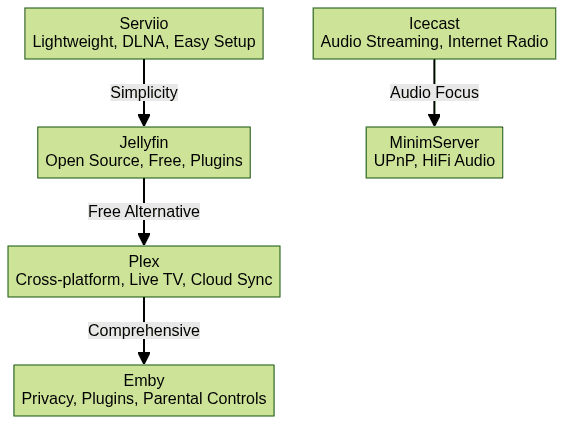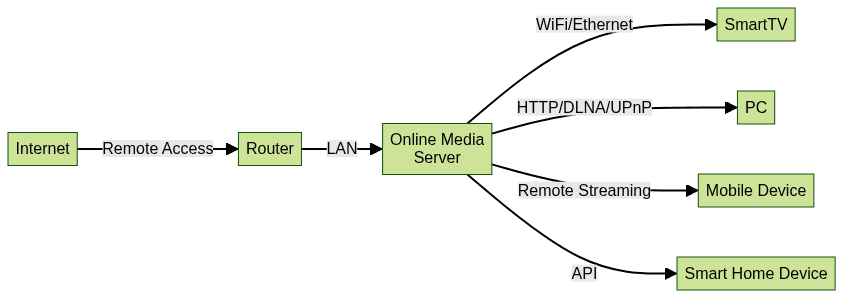Introduction to Online Media Servers
An online media server is a software system designed to store, organize, and stream digital media content (videos, music, images) over a network, enabling access from a variety of connected devices. In 2025, with the proliferation of high-speed internet and smart devices, online media servers are pivotal for home entertainment, remote access, and seamless media sharing. Whether you want to build a personal media server for your home, share content with family remotely, or manage a robust entertainment library across multiple devices, an online media server offers a flexible, centralized solution. With support for various streaming protocols and transcoding features, these servers ensure media is accessible, compatible, and secure on nearly any platform.
Key Features of Online Media Servers
A modern online media server delivers a suite of features tailored for seamless media streaming and device interoperability:
- Media Streaming: Stream music, video, and images to Smart TVs, PCs, tablets, phones, and browser-based players.
- Device Compatibility: Support for Android TV, Apple TV, Roku, game consoles, and NAS devices via standardized protocols.
- Media Protocols: Utilizes UPnP (Universal Plug and Play), DLNA (Digital Living Network Alliance), and HTTP for device discovery and direct streaming.
- Transcoding: On-the-fly media conversion ensures compatibility across different devices and bandwidth scenarios.
- Parental Controls & Privacy: Fine-grained user permissions, parental controls, and privacy settings to manage access and protect sensitive content.
For developers and advanced users, integrating a
Live Streaming API SDK
can further enhance your server’s capabilities, enabling interactive live streaming features directly within your media environment.These features make online media servers indispensable for both home and remote streaming environments in 2025.
Popular Online Media Server Solutions
Several open source and commercial solutions dominate the online media server landscape, each offering unique strengths:
Plex
Plex is a comprehensive online media server platform featuring intuitive media library management, remote streaming, built-in transcoding, and robust support for live TV and DVR. Plex offers cross-platform compatibility and cloud sync, making it a top choice for both home and mobile access. If you’re looking to add real-time communication to your Plex setup, consider using a
Video Calling API
to enable seamless video calls directly from your media server interface.Emby
Emby focuses on privacy and user control while providing advanced transcoding and device compatibility. Its open architecture supports extensive plugins, and it offers strong parental controls, making it popular among power users seeking customizability. For those interested in audio-only features, integrating a
Voice SDK
can add live audio room capabilities to your Emby server.Jellyfin
As a fully open-source and free online media server, Jellyfin appeals to developers and privacy-conscious users. It supports a wide range of devices, streaming protocols, and plugins, with active community development and no recurring fees. If you’re developing for mobile, check out
webrtc android
solutions for real-time streaming and communication on Android devices.Serviio
Serviio is a lightweight, DLNA-compliant online media server, ideal for users requiring simple, fast media streaming with minimal configuration. It supports a broad range of devices and automatic media library management. Developers working with cross-platform apps may benefit from exploring
flutter webrtc
for building real-time video and audio features.Icecast and MinimServer
Icecast specializes in audio streaming (Internet radio), while MinimServer is optimized for high-fidelity, UPnP-based music streaming, making them perfect for audiophile setups. For web-based applications, leveraging a
javascript video and audio calling sdk
can enable browser-based communication features alongside your media streaming.Comparison Table

How Online Media Servers Work
Understanding the architecture and protocols of an online media server is crucial for effective setup and optimization.
Network Architecture
Most online media servers follow a client-server model where the server hosts the media library, and clients (apps, devices, browsers) access content via the network. If you want to quickly add video calling to your web app, you can
embed video calling sdk
components for instant integration without extensive development.
Device Discovery and Streaming Protocols
- UPnP/DLNA: Enables automatic discovery and direct streaming to compatible devices.
- HTTP/HTTPS: Supports browser-based playback and remote streaming.
- REST API: Allows for integration with smart home assistants, custom apps, and automation. For mobile developers, integrating a
react native video and audio calling sdk
can bring advanced communication features to your cross-platform media apps.
On-the-Fly Transcoding
Transcoding is the process of converting media formats in real-time to match client capabilities and network conditions. Most servers use FFMPEG or similar libraries for this.
1ffmpeg -i "input.mkv" -c:v libx264 -preset fast -crf 23 -c:a aac -b:a 128k "output.mp4"
2This basic ffmpeg command converts an MKV video to an MP4 (H.264/AAC), balancing quality and compatibility for online media streaming.
Remote and Local Streaming
- Local Streaming: Direct streaming over LAN for minimal latency and maximum quality.
- Remote Streaming: Securely streams media over the internet, with adaptive transcoding for bandwidth optimization. For those looking to add interactive broadcast features, another
Live Streaming API SDK
can be integrated to power scalable live events from your server.
Step-by-Step Guide: Setting Up Your Own Online Media Server
Choosing the Right Platform
Select a server solution (Plex, Emby, Jellyfin) based on your requirements: open source, device support, advanced features, or privacy.
Hardware and Software Requirements
A modest PC, NAS, or even a Raspberry Pi suffices for most setups. Ensure adequate CPU/RAM for transcoding; install Linux, Windows, or Docker as needed.
Installation and Initial Setup
- Download your chosen server software.
- Install following official documentation (e.g., using Docker for isolation and portability):
1docker run -d \
2 --name=plex \
3 -e PUID=1000 -e PGID=1000 \
4 -e TZ=Europe/London \
5 -p 32400:32400 \
6 -v /path/to/config:/config \
7 -v /path/to/media:/media \
8 plexinc/pms-docker
9- Access the web interface (e.g.,
http://localhost:32400
) and follow the setup wizard. - Create user accounts, set library folders, and configure streaming/transcoding options.
Adding and Organizing Media Content
Organize your media folders logically (e.g., Movies, TV Shows, Music). Use consistent naming conventions for accurate metadata and cover art scraping.
Securing Your Server (Privacy, Users, Parental Controls)
Set strong admin passwords, restrict access via firewall rules, enable HTTPS for remote access, and configure user profiles with parental controls as needed.
Accessing Media Remotely
Configure port forwarding or use built-in remote access features (e.g., Plex Relay). Use secure connections and optionally enable two-factor authentication.
Troubleshooting Common Issues
- Transcoding Failures: Ensure sufficient hardware resources and install codecs.
- Connectivity Issues: Check network/firewall settings and client compatibility.
- Metadata Errors: Standardize file names and rescan libraries.
Advanced Features and Customizations
- Cloud Sync & Mobile Access: Sync libraries with cloud storage providers for redundancy and offline playback on mobile devices.
- Live TV & DVR Integration: Connect USB tuners or IPTV sources for watching and recording live TV directly through your online media server.
- API & Plugin Support: Leverage RESTful APIs for automation, integrations, and custom plugins (e.g., Discord notifications, home automation triggers).
- Voice Control & Smart Home Integration: Integrate with Alexa, Google Assistant, or custom voice commands for hands-free navigation and playback control.
Best Practices for Managing an Online Media Server
- Regular Updates & Backups: Keep server software and plugins up-to-date. Schedule regular backups of your media library and configuration.
- Network Optimization: Use wired connections for servers; ensure sufficient bandwidth and prioritize media traffic via QoS settings.
- User Management & Monitoring: Review user activity, adjust permissions, and monitor resource usage to maintain performance and security.
Conclusion
Setting up an online media server in 2025 empowers you to centralize, manage, and stream your digital media collection across all your devices. With robust open source and commercial solutions available, plus advanced features like transcoding and cloud sync, there has never been a better time to take control of your entertainment.
Try it for free
and start building your online media server today to experience seamless media sharing, privacy, and convenience tailored to your needs.Want to level-up your learning? Subscribe now
Subscribe to our newsletter for more tech based insights
FAQ